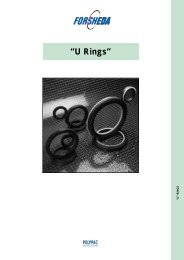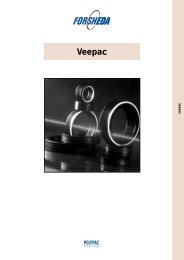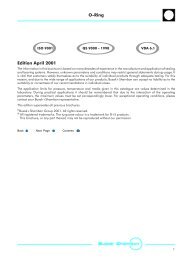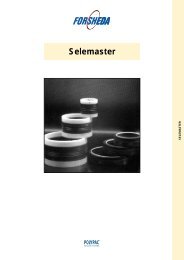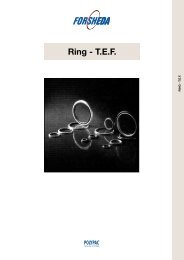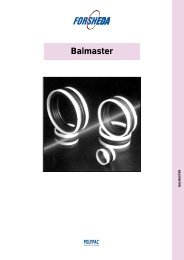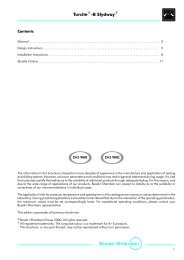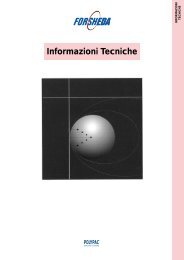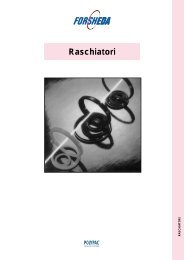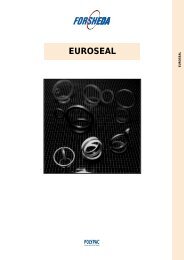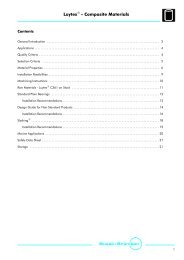Rotary Seals - Dilanda.it
Rotary Seals - Dilanda.it
Rotary Seals - Dilanda.it
You also want an ePaper? Increase the reach of your titles
YUMPU automatically turns print PDFs into web optimized ePapers that Google loves.
Radial Oil Seal<br />
Lubrication<br />
Adequate lubrication is of extreme importance as regards<br />
the function and useful life of the seal. A film of liquid<br />
must be formed between the sealing lip and the shaft in<br />
order to minimize friction and the associated generation of<br />
heat and wear and thus to avoid destruction of the lip<br />
material. In cases where the sealed medium is oil or grease,<br />
lubrication does not normally present a problem. However,<br />
care must always be taken to ensure that the lubricant<br />
comes in contact w<strong>it</strong>h the sealing lip. Components such as<br />
gearwheels, oil thrower and taper roller bearings exert a<br />
pumping action which e<strong>it</strong>her prevents the lubricant from<br />
reaching the seals or causes a heavy flow of lubricant to be<br />
directed towards the seal. In the former case, circulation<br />
passages should be provided to ensure that the seal is<br />
lubricated. In the latter case, the flow may cause a pressure<br />
rise in excess of the permissible values. In machines where<br />
the lip seal is not normally lubricated, grease or oil must be<br />
supplied by other means. Prior to installation the seal must<br />
be pre-lubricated w<strong>it</strong>h oil or grease. In some cases this<br />
lubrication during the installation may be sufficient. On<br />
seals w<strong>it</strong>h double lip the space between the lips should be<br />
filled to about 50% w<strong>it</strong>h grease before installation. A wide<br />
range of oils and lubricants are available on the market,<br />
and these may have different effects on the elastomers.<br />
Care should therefore be taken to ensure that the lubricant<br />
used is not detrimental to the lip material. See the<br />
resistance Table V.<br />
Lubrication and leakage<br />
Absolute tightness cannot possibly be achieved. The<br />
medium to be sealed also lubricates the lip and affects<br />
the service life of the seal. A complete dry running destroys<br />
the sealing lip. The German standard DIN 3761 classifies the<br />
tightness of lip seals into leakage classes 1 to 3. A so called<br />
zero-leakage is also defined. Zero-leakage means a<br />
function related film of moisture at the sealing edge to a<br />
non-drip formation of medium over the back-face of the<br />
seal. It is better to accept this “minimum leakage“ rather<br />
than risking the lip to be damaged due to insufficient<br />
lubrication. The permissible leakage in class 1 to 3 is max<br />
1 g to 3 g per seal for a test time of 240 hours.<br />
special design of the sealing lip, reduction of the spring<br />
force or by employing a special grade of rubber. Our<br />
technical department will be pleased to provide advice on<br />
such matters. It should be noted that the frictional loss<br />
during the “running in“ period is greater than shown in<br />
the figure. The normal “running in“ period is a few hours.<br />
After a long period of standing idle the starting friction<br />
may be also relatively high.<br />
Frictional loss, W<br />
Figure 12<br />
350<br />
300<br />
250<br />
200<br />
150<br />
100<br />
50<br />
ø 200<br />
ø 150<br />
ø 125<br />
ø 100<br />
0<br />
0 5 10 15 20 25<br />
Peripheral speed, m/s<br />
Frictional loss for TRA/CB type<br />
seal of n<strong>it</strong>rile rubber<br />
ø 80<br />
ø 70<br />
ø 60<br />
ø 50<br />
ø 40<br />
ø 30<br />
ø 20<br />
ø 10<br />
Frictional loss<br />
The frictional loss is often of significant magn<strong>it</strong>ude,<br />
particularly when low powers are transm<strong>it</strong>ted. The<br />
frictional loss is affected by the following parameters:<br />
seal design and material, spring force, speed, temperature,<br />
medium, shaft design, and lubrication. Figure 12 shows the<br />
frictional losses in watts caused by a seal w<strong>it</strong>hout dust lip<br />
when f<strong>it</strong>ted in accordance w<strong>it</strong>h our technical instructions.<br />
In certain cases the frictional loss can be reduced by a<br />
26<br />
Latest information available at www.busakshamban.com<br />
Ed<strong>it</strong>ion April 2006



